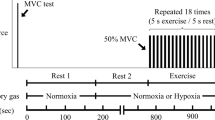Summary
Ventilatory threshold, apparent mechanical efficiency, oxygen debt repayment, heart rate and perceptions of exertion at the ventilatory threshold have been examined in 8 men and 8 women during the performance of four types of exercise (2-leg, 1-leg, arm plus shoulder, and arm ergometry) under normoxic and hypoxic (12% oxygen) conditions. The ventilatory threshold (percentage of task-specific\(\dot V_{o_{2max} } \) at which a disproportionate increase of ventilation begins) was not significantly affected by the sex of the subject, by hypoxia, or by the volume of active muscle involved in the activity, but showed poor reproducibility in small muscle tasks. The apparent mechanical efficiency in 2-leg ergometry was increased from 25.7 to 28.1% under hypoxic conditions, presumably reflecting an increased contribution of anaerobic effort to sub-maximal work. However, oxygen debt repayment following exhausting exercise was much smaller for arm than for leg ergometry. The heart rate corresponding to the ventilatory threshold decreased as the volume of active muscle was reduced. General and respiratory perceptions of effort were rather light for self regulation of an exercise prescription to the ventilatory threshold, and particularly with tasks involving the arm muscles, prescription may best be regulated by the intensity of local muscular sensations.
Similar content being viewed by others
References
Borg G (1971) The perception of physical performance. In: Shephard RJ (ed) Frontiers of fitness. C. C. Thomas, Springfield, Ill, pp 280–294
Brooks GA (1985) Response to Davis' manuscript. Med Sci Sports Exerc 17:19–21
Cerretelli P (1967) Lactacid O2 debt in acute and chronic hypoxia. In: Margaria R (ed) Exercise at altitude. Excerpta Medica, Dordrecht, pp 58–64
Davis JA (1985) Anaerobic threshold: review of the concept and directions for future research. Med Sci Sports Exerc 17:6–18
Davis JA, Vodak P, Wilmore JH, Vodak J, Kurtz P (1976) Anaerobic threshold and maximal aerobic power for three modes of exercise. J Appl Physiol 41:544–550
Durnin JVGA, Womersley J (1974) Body fat as assessed from total body density and its estimation from skinfold thickness: measurements on 481 men and women from 16 to 72 years. Br J Nutr 32:77–97
Gollnick PD, Armstrong RB, Saubert CW, Piehl K, Saltin B (1972) Enzyme activity and fiber composition in skeletal muscles of untrained and trained men. J Appl Physiol 33:312–319
Hetenyi G, Perez G, Vranic M (1983) Turnover and precursor-product relationships of non-lipid metabolites. Physiol Rev 63:606–667
Hollmann W (1961) Zur Frage der Dauerleistungsfähigkeit. Fortschr Med 79:439–453
Hughson R, Green H (1982) Blood acid-base balance and lactate relationship studied by ramp work tests. Med Sci Sports Exerc 14:297–302
Jones NL (1980) Hydrogen ion balance during exercise. Clin Sci 59:85–91
Neary PJ, Wenger HA (1986) The effect of one and two legged exercise on the lactate and ventilatory threshold. Eur J Appl Physiol 54:591–595
Paterson DJ, Morton AR (1986) Maximal aerobic power, ventilatory and respiratory compensation threshold during arm cranking and bicycle ergometry. Austr J Sci Med Sport 18:11–15
Shephard RJ (1977) Endurance fitness. 2nd Ed. University of Toronto Press, Toronto
Shephard RJ (1982) Physiology and Biochemistry of Exercise. Praeger, New York
Shephard RJ, Bouhlel E, Vandewalle H, Monod H (1988) Muscle mass as a factor limiting physical work. J Appl Physiol 64:1472–1479
Vogel JA, Gleser MA (1972) Effect of carbon monoxide on oxygen transport during exercise. J Appl Physiol 32:234–239
Wasserman K, McIlroy MB (1964) Detecting the threshold of anaerobic metabolism in cardiac patients during exercise. Am J Cardiol 14:844–852
Wasserman K, Whipp BJ, Koyal SN, Beaver WL (1973) Anaerobic threshold and respiratory exchange during exercise. J Appl Physiol 35:236–243
Weiner JS, Lourie JA (1981) Practical human biology. Academic Press, London
Woodson RD, Wills RE, Lenfant C (1978) Effect of acute and established anaemia on O2 transport at rest, submaximal and maximal work. J Appl Physiol 44:36–43
Author information
Authors and Affiliations
Rights and permissions
About this article
Cite this article
Shephard, R.J., Bouhlel, E., Vandewalle, H. et al. Anaerobic threshold, muscle volume and hypoxia. Europ. J. Appl. Physiol. 58, 826–832 (1989). https://doi.org/10.1007/BF02332214
Accepted:
Issue Date:
DOI: https://doi.org/10.1007/BF02332214




